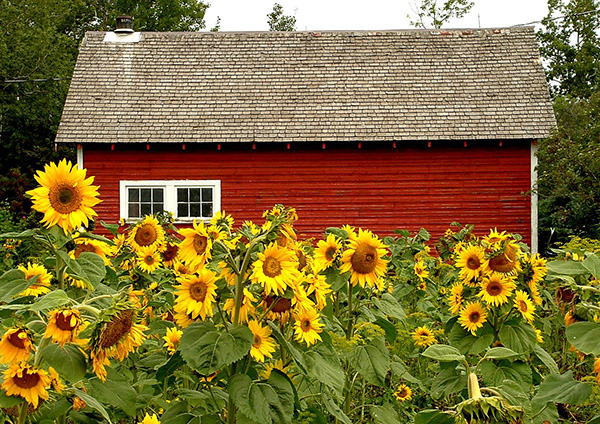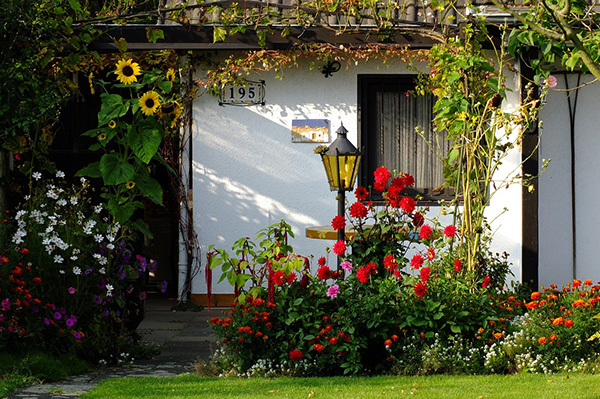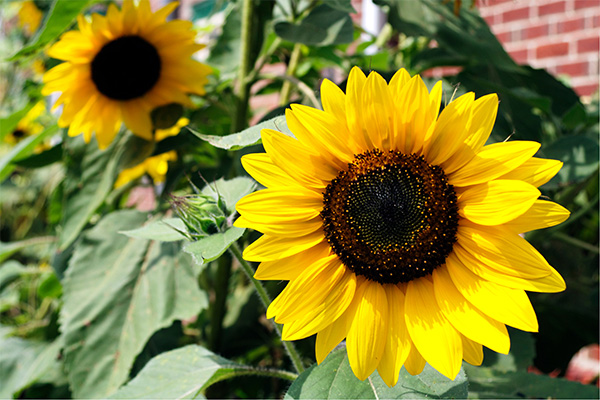When it comes to gardening, few flowers evoke the warmth and cheerfulness of a sunflower. These towering beauties are a staple of picturesque countryside fields, and you can also find a happy home in your garden. Growing sunflowers is incredibly rewarding and brings a touch of summer's radiance to your outdoor space. Whether you're an experienced gardener or embarking on your journey into gardening, discovering the art of nurturing these radiant giants is a delightful and uncomplicated endeavor.
In this guide, we'll walk you through the steps to how to grow sunflowers that will reach for the sky, brighten your days, and even bring a smile to the faces of passersby.
Botanical Name
Common Name
Plant Type
Mature Size
Sun Requirement
Soil Type
Hardiness Zone
Pet Friendly
Helianthus annuus
Sunflower
Annual
3–10 ft. tall, 1.5–3 ft. wide
Full
Well-drained
2–11 (USDA)
Yes
What is A Sunflower Plant
A sunflower, scientifically known as Helianthus annuus, is a stunning and iconic flowering plant characterized by its large, vibrant yellow blooms with dark central discs. These cheerful flowers are native to North America but have become beloved worldwide for their sunny appearance.
Sunflowers are renowned for their towering and robust stems, capable of achieving impressive heights, occasionally surpassing 10 feet. They are a favorite among gardeners, admired not only for their beauty but also for their edible seeds, which are a popular snack and source of oil. Sunflowers are annual plants that thrive in full sun, symbolizing positivity and brightness in gardens and landscapes.

Sunflower Plant Care Requirements
Light
Sunflowers are renowned for their affinity for sunlight, earning them their name. Thriving in abundant sunlight, these joyful blooms demand a minimum of 6 to 8 hours of direct sun exposure daily to achieve their maximum potential. When planning to grow sunflowers, selecting a location with ample sunshine is crucial. The more sunlight they receive, the taller and more robust they'll grow, with larger and more vibrant blooms.
To maximize sun exposure, choose a spot facing south or southwest in your garden, ensuring they receive the most sunlight throughout the day. Sunflowers are recognized for their phototropic behavior, wherein they track the sun's movement across the sky, a phenomenon referred to as heliotropism. While this trait is intriguing, it's essential to acknowledge that it is more pronounced in younger sunflowers and tends to diminish as they mature.
Water
Proper watering is essential for the successful growth of sunflowers. While these resilient plants are known for their drought tolerance, they still require consistent moisture, especially during their early stages.
When you first plant sunflower seeds, ensure the soil is well-moistened. Gradually decrease watering frequency once sunflowers germinate and establish their root systems. Strive to deliver approximately 1 inch of water per week through natural rainfall or irrigation. It is crucial to water deeply, ensuring moisture penetrates the soil to a depth of 6 to 8 inches, as this fosters the growth of deep and robust roots.
Keep an eye on your sunflowers during dry spells, as they may need more frequent watering. Nevertheless, it is vital to avoid overwatering, as excessively saturated soil can result in complications such as root rot and other issues. Applying mulch around the base of the plants can help conserve moisture.
Temperature
Sunflowers are resilient plants with adaptable temperature requirements, rendering them well-suited for diverse climates. They thrive in warm weather and prefer temperatures between 70°F to 78°F (21°C to 26°C) during their growth phase. However, sunflowers are also adaptable and can tolerate higher temperatures, even exceeding 90°F (32°C), as long as they receive adequate moisture.
Sunflowers are typically grown annually, and sunflower seeds can be sown in spring after the danger of frost has passed. Lacking frost tolerance, it is crucial to plant sunflowers when the soil has sufficiently warmed up. These plants respond positively to the warmth of the summer months, which accelerates their growth and flowering.
Soil
Sunflowers are relatively undemanding regarding soil requirements, but a few key factors can help ensure their optimal growth. They perform best in well-drained, loamy soil rich in organic matter. To prevent root rot, ensuring good drainage is essential to avoid waterlogged roots.
Although sunflowers tolerate various soil pH levels, they flourish in slightly acidic to neutral soils, ideally with a pH ranging from 6.0 to 7.5. Conducting a soil test to ascertain the pH level and make any required adjustments using lime or sulfur is advisable.
Moreover, sunflowers thrive in soil that has been adequately prepared with organic compost or well-rotted manure, promoting enhanced fertility. This provides essential nutrients that promote healthy growth and vibrant blooms. To ensure a thriving sunflower garden, choose a sunny location with well-drained, fertile soil, and you'll be rewarded with the iconic sight of these cheerful flowers reaching for the sky.
Fertilization
Feeding sunflowers is a straightforward procedure that can markedly improve their growth and overall health. These resilient plants are not particularly heavy feeders; providing them with the right nutrients can result in larger, more robust blooms.
When planting sunflowers, mixing a well-balanced, all-purpose fertilizer into the soil is advantageous. A recommended practice is to employ a fertilizer with an even N-P-K (nitrogen-phosphorus-potassium) ratio, like 10-10-10, during the initial planting. This provides the necessary nutrients for strong root development.
As sunflowers grow, a light application of a balanced fertilizer can be applied when they reach a height of about a foot tall. This practice promotes robust stem and leaf development.
It's important not to over-fertilize sunflowers, as excessive nitrogen can lead to excessively tall plants that may become top-heavy and prone to tipping over. Following recommended fertilizer application rates and guidelines are key to supporting the optimal growth of these cheerful blooms.
Pruning
Pruning sunflowers may not be common, as these plants typically grow naturally with minimal intervention. However, there are situations where a bit of pruning can be beneficial.
Deadheading, which involves removing spent flowers, is a straightforward pruning method that encourages continuous blooming. Trimming off the withered sunflower heads redirects the plant's energy away from seed production, promoting the generation of more flowers. This can result in a longer blooming period and more vibrant blooms.
Additionally, if you have exceptionally tall sunflowers at risk of toppling over due to their height, you can prune the top portion of the stem to reduce their overall height. It's essential to approach deadheading with care and restraint to prevent hindering the plant's overall growth.
Propagation
Sunflower propagation involves growing new sunflower plants from seeds or cuttings. Here, we'll focus on the propagation of sunflowers from seeds, which is the most common and straightforward method.
To propagate sunflowers from seeds, start by collecting mature sunflower heads once they have fully ripened, and the back of the flower head has turned brown. This practice is usually carried out in late summer or early fall.
Gently extract the seeds from the sunflower head by either rubbing the head or using your fingers to release them from their attached disks.
Spread the gathered seeds flat and allow them to dry for approximately a week. This helps reduce moisture content and prevent mold formation during storage.
Store the dried sunflower seeds in a cool, dry location, preferably in an airtight container, until you are prepared to plant them. When stored appropriately, sunflower seeds can remain viable for several years.
When you're ready to propagate, sow sunflower seeds directly into well-prepared soil in your garden. In addition, you can also grow sow seeds in a small pot and then transplant them when they get bigger. Plant sunflower seedlings at a depth of about 1 inch (2.5 cm) and provide adequate spacing, as sunflowers can grow quite large.
Typically, sunflower seeds germinate within 7-10 days under optimal conditions, which include well-drained soil and ample sunlight. As the young sunflower plants grow, ensure they receive adequate water and sunlight. Sunflowers are known for their phototropic nature, meaning they turn their blooms to follow the sun's path, so they'll naturally seek sunlight.
Harvest
Harvesting sunflower seeds is a rewarding culmination of the sunflower growing process. Understanding when and how to harvest sunflower seeds is essential for reaping a bountiful harvest.
When to Harvest
Sunflower seeds are ready to harvest when the flower head has fully matured. You can determine the right time when the back of the flower head transitions from green to yellow or brown and the flower petals have withered and fallen off. Additionally, the seeds should appear plump and firm and have a black or gray stripe. This transition typically occurs in late summer to early fall, approximately 120 to 150 days after the initial planting.
How to Harvest
Gather a pair of sharp garden shears or scissors, a bucket or container, and a clean cloth or tarp for seed collection.
Carefully sever the mature flower head from the stem, leaving about three to four inches of stem attached to the head. This remaining stem will serve as a handle during the drying process.
Suspend the harvested sunflower heads upside down in a dry, well-ventilated area, such as a garage or garden shed. Ensure the heads are adequately spaced apart to facilitate proper air circulation. Drying typically takes one to two weeks, during which any remaining moisture in the flower head and seeds will evaporate.
After completely drying the flower heads, you can start extracting the seeds. This can be achieved by gently rubbing the head with your hands or using a fork to loosen the seeds. Work over a large container or a clean cloth to catch the seeds as they fall.
After sunflower seed removal, it's common to have some chaff (the papery material around the seeds) mixed in with the seeds. To separate the seeds from the chaff, employ a method known as winnowing. This involves pouring the seeds from one container to another on a breezy day, allowing the wind to carry away the lighter chaff, leaving you with clean seeds. Alternatively, you can use a fan to achieve the same separation effect.
After separating the seeds from the chaff, store the harvested sunflower seeds in airtight containers. Mason jars or resealable plastic bags are suitable for this purpose. Place the containers in a cool, dry location away from direct sunlight. Properly dried and stored sunflower seeds can remain viable for planting in the next growing season or be enjoyed as a nutritious snack.

Common Problems And Troubleshoots
Pest Infestations
Sunflowers can be susceptible to various pests, including aphids, caterpillars, and birds. These pests can damage your sunflowers' leaves, stems, and seeds. To tackle this issue, it's essential to inspect your sunflowers regularly for signs of infestation. In the presence of aphids or caterpillars, contemplate utilizing insecticidal soap or neem oil, which are effective and safe solutions. Cover the flower heads with a mesh bag or cheesecloth to protect the seeds from hungry birds as they begin to ripen. Another preventive measure is to plant companion flowers like marigolds, which can help deter pests from your sunflowers.
Disease
Sunflowers are not immune to fungal diseases like powdery mildew or downy mildew, which can affect their leaves and overall health. To prevent and address these diseases, it's crucial to maintain adequate spacing between your sunflowers. Good air circulation can significantly reduce the risk of fungal infections. If you observe signs of disease, promptly remove the affected plant parts and contemplate using fungicides if necessary.
Poor Soil Quality
The quality of your soil plays a vital role in the health and growth of your sunflowers. They may not thrive in poor or compacted soil. To improve garden soil fertility and drainage, it's advisable to amend it with organic matter like compost before planting sunflowers. This amendment enriches the soil and provides better conditions for root development, resulting in healthier plants.
Overwatering
While sunflowers require consistent moisture, overwatering can result in root rot, which can be detrimental to your plants. To circumvent this issue, water your sunflowers moderately and ensure the soil has proper drainage. Avoid letting the soil become waterlogged or soggy, as this can compromise root health. Before watering, always assess the soil's moisture level and adjust your watering frequency according to prevailing environmental conditions.
Tall Sunflowers Tipping Over
If you're growing exceptionally tall sunflowers, they may become top-heavy and prone to tipping over, especially in windy conditions. It's advisable to stake tall sunflowers for additional support to prevent this. Drive a tall stake into the ground near the sunflower's stem and gently tie the plant to the stake as it grows. This provides stability and ensures that your sunflowers stand tall and proud.
Lack of Sunlight
Sunflowers are renowned for their love of sunlight, and insufficient light can result in weak, leggy growth. To ensure your sunflowers flourish, plant them in a location that receives a minimum of 6-8 hours of direct sunlight daily. This ensures sturdy and healthy growth; sunflowers thrive in sunny environments.
Attracts unwanted garden visitors
Sunflowers' vibrant blooms and nutritious seeds can attract charming but sometimes troublesome garden visitors like birds and squirrels. The issue arises when these animals start feasting on your sunflower seeds, potentially causing damage and creating a mess in your garden.
To address this concern, you can take several measures. Harvest your sunflower heads a bit earlier, cover ripening heads with protective mesh bags or bird netting, use scare tactics like reflective tape or motion-activated sprinklers, offer a separate bird feeder to divert their attention, try repellents, and consider planting extra sunflowers to share with local wildlife. These strategies help strike a balance between wildlife enjoyment and garden preservation.
Slug and snails
Growing sunflowers can be a joy, but it's not without its challenges, and one common issue gardeners face is the presence of slugs and snails. These slimy creatures are attracted to the tender shoots and leaves of sunflowers, posing a threat to your garden. Slugs and snails can leave behind a trail of destruction, munching on foliage and even damaging the emerging flower buds. To protect your sunflowers, consider using natural deterrents like copper tape or crushed eggshells around the base of the plants. Additionally, keeping your garden clean and debris-free can help reduce hiding spots for these garden pests, ensuring your sunflowers thrive.
Is the Sunflower plant pet-friendly?
Sunflower plants are a pet-friendly choice for your garden or home. They are non-toxic to both dogs and cats, making them a safe and cheerful addition to spaces shared with furry friends. Their bright blooms can add beauty to your environment without worrying about pet health risks.

FAQs
When to plant sunflowers
The optimal time for planting sunflowers is in late spring or early summer when the soil has warmed to around 50°F (10°C) or higher. This timing ensures that the soil is not too cold, allowing sunflower seeds to germinate and grow vigorously in the warmth of the upcoming summer months.
Refer to the seed packet for specific instructions if you plan to cultivate store-bought varieties.
Do sunflowers need support?
While most sunflowers are sturdy and self-supporting, tall varieties with heavy flower heads may benefit from support. Support the plants with stakes when they reach a height slightly exceeding one foot to avoid the risk of them toppling over in the face of strong winds or heavy rain.
How do I harvest sunflower seeds?
Harvest sunflower seeds when the flower head has fully matured, the seeds have turned plump, and a black or gray stripe has developed. Sever the head from the stem and let it dry in a well-ventilated space. After thoroughly drying, delicately rub the seeds from the head and store them in a cool, dry location.
Can I grow sunflowers in containers or window boxes?
Yes, smaller sunflower varieties, such as dwarf sunflowers, are suitable for container gardening. Choose a deep container with good drainage, use quality potting soil, and place it in a sunny spot for successful container-grown sunflowers.
Do sunflowers attract wildlife?
Sunflowers are known to attract various wildlife, including birds and squirrels, especially when the seeds ripen. Protective measures like netting or scare tactics can help deter these animals from decimating your sunflower heads.
Can I save sunflower seeds for replanting?
Absolutely, you can save sunflower seeds for future planting. Ensure that the harvested seeds are completely dry to prevent mold or rot. Keep the seeds in airtight containers stored in a cool, dry location until you are prepared to plant them again in the following season.
